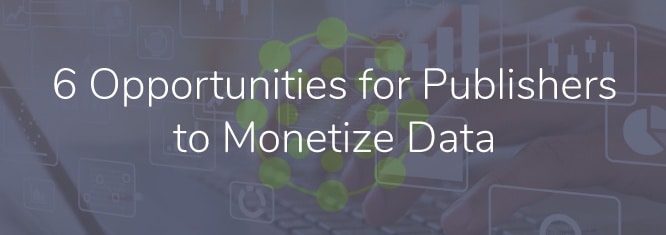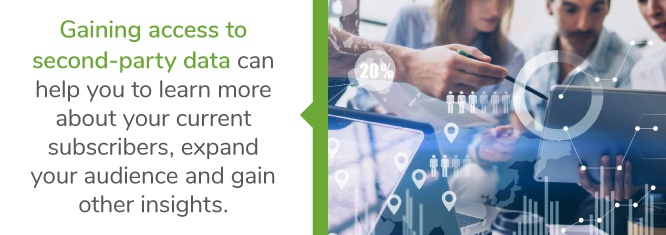
People often say that data is the new currency, especially for marketers. It enables them to gain valuable insights into their audiences and drive more sales. What some people forget, though, is that data also has huge potential value for publishers. They can use it in many of the same ways that marketers do as well as for some purposes unique to media owners.
Publishers’ first-party data, as well as second-party and third-party data, can help drive revenue for them, both directly and indirectly. There are many creative ways in which publishers can monetize their data.
Want to get started with data monetization? Here are six opportunities to take advantage of, starting today.
1. Making Audiences More Sellable to Advertisers
Publishers can use data to make their audiences more sellable to advertisers. You can do this by organizing audience data from across various media properties, which allows you to scale your audiences. Better audiences mean more effective ads, which means more advertisers will be interested in your site.
One of the best ways to improve data quality and make your audiences more sellable is to use a data collaboration platform, or DCP.
A DCP helps you to onboard, connect, enrich and activate your data so that you can use it to boost revenue. DCPs can pull your first-party data from across all of your sites and integrate third-party data as well to make that information more valuable. They also allow for the ability to partner externally for actionable customer intelligence, data informed audiences, and identity powered activation.
Within a DCP, you can organize your audience data according to interests, demographics, purchase history, or however your business choses to organize it.
By putting one or more data points together to build audiences, you can look at the insights and audience profile reports to learn more about each group. When you know more about your audiences, you can share that knowledge with advertisers to help them reach their target consumers more precisely.
Say, for instance, you have an advertiser who sells kitchenware. The first place you would think to put those ads would be in the recipes section of your site, since the people who visit that section most likely enjoy cooking. With a DCP, however, you could create an audience of users who have a lot of interest in cooking and kitchenware, and then display those kitchenware ads across your entire site aimed specifically at those users, rather than just in your recipes section.
Since your DCP allows you to access information about your audience’s interests, you could sell ad space to a kitchenware company even if your site has nothing to with cooking, appliances or home goods. A DCP gives you insights into your audience’s interests beyond your specific site, which provides you with the opportunity to work with advertisers you never could before.
2. Increasing Average CPM
Publishers can also use data to achieve a higher average CPM, the cost for every thousand impressions of an ad on a webpage. Higher CPMs mean higher online ad revenue for publishers.
As mentioned earlier, better-targeted audiences are more sellable. When you use a DCP to segment audience data and gain useful insights about your audience, your inventory becomes more valuable to advertisers. When advertisers know they are reaching an engaged audience on your site, they’ll pay more to have their ads there.
CPM prices also vary based on the type of ad and how well those ads perform on a certain site. By looking back at your data, you can determine which ads performed best and which earned the highest CPMs. You can then focus your efforts on these types of ads. For example, you might find that video ads work especially well. Your data might also tell which topics in ads your publication viewers respond to best.
You can also use data to attract more visitors to your site and keep the readers you already have around for longer by offering better content. When you have more visitors, your site brings in more impressions, which means more people who see your ads. Again, this makes your site more valuable to advertisers.
Because, in the CPM model, the publisher gets paid for every thousand impressions, more impressions mean more ad revenue. The increased value that data brings to your ad inventory also allows you to earn higher average CPM.
3. Reducing Remnant Inventory
There are two types of inventory, or ad spaces, on every publisher’s site — premium inventory and remnant inventory. In general, premium ad space is of a higher-quality and is, therefore, worth more. Publishers typically sell these types of ads directly, but they can also sell them programmatically.

Remnant inventory, as its name suggests, is inventory that’s left over after the premium space has all been sold. It doesn’t command as high of a price as premium inventory and is often sold via ad exchanges or networks.
Ideally, you’ll sell all of your ad space as premium inventory, but in reality, that typically doesn’t happen. It’s possible, though, to convert more of your remnant inventory to premium. If you do this, you can substantially increase the revenue you earn from ads.
As the value of your ad space, and the value of your website as a whole, go up, your inventory will sell faster and for high prices. As a result, more of it will be considered premium.
Data is what drives this increase in value. With data, you can bring more visitors to your site. It also enables you to sell audiences rather than sections of your site and reach advertisers you wouldn’t otherwise sell to without audience data. This boosts the overall value of your site to advertisers and puts your ad space in higher demand, making it easier to sell ad space. As a result, you’re able to sell more space as premium rather than remnant.
4. Growing Your Audience and Revenue
By identifying the characteristics of their subscribers, publishers can use data to expand their audiences as well as upsell and cross-sell to existing users.
You can use your DCP to access insights into the characteristics of the people who subscribe to your site. You might find that a certain demographic, such as women or people ages 18-24, are most likely to subscribe, for example. You might also realize that your regular readers have various interests in common, beyond what you would expect based on the content of your publication. Perhaps, for instance, you run an online golf magazine, so you know your readers are interested in golf. Your data might show you that large portions of your audience are also interested in fine wine, bowling or apparel.
With the DCP, you can then create audiences that have characteristics similar to those of your subscribers and target them. Since they’re similar to your current audience, they’re more likely to want to subscribe. In this sense, publishers become their own marketers and serve ads or other promotional materials to people they believe are their target audience. The golf magazine in the earlier example might target men ages 50 to 70 with advertisements on a wine site, for instance.
Publishers can also use their data to upsell and cross-sell to their subscribers. Data, including first-party data such as purchase history and third-party data, can help you predict which subscribers are more likely to make other purchases from you. You can use a similar approach to the one described above. When you identify the characteristics of customers that make purchases, you can target people with similar qualities to get a better chance of an upsell.
5. Customizing Content
You can also encourage viewers to stay on your site longer by using data to optimize its performance. Insights from your DCP enable you to serve the right content to the right viewers at the right time. This will encourage users to stick around on your site for longer so that they can view more content and see more ads.
Your data will reveal to you what kinds of content are performing the best with your audience. When you create new content, you can focus on the areas and have more assurance that the content will be popular with your subscribers. This information might give you some direction as to the format of your content as well as the topics you should cover.
It also enables you to drill down further and personalize content recommendations for individual users or segments of users. Your data will tell what a particular reader’s interests are, allowing you to show them content that deals with those interests. If they read a lot about fashion, for instance, you would serve them content related to fashion. You can also show them content about interests you know they have, or believe they are likely to have, because of your data.
You can do this even if they haven’t explicitly revealed those interests through their actions on your site. Find out what they like through your data, and you can direct them to an area of your site that they haven’t explored before but are likely to be interested in.
When you show readers content they could find interesting, they will likely stay on your site longer. After they read an article, for example, you can recommend related stories to them. Because this article caters to their interests, they’re more likely to click on it. This means they’ll see more of your content and more of your ads, reducing your site’s bounce rate and increasing stickiness. These qualities make your ad space more valuable as well.
6. Selling Data or Data Collaboration
Selling data can open up more opportunities for your business. There are several options for selling your data. The first could include opting in to sell your data via a third-party data exchange, such as the Lotame Data Exchange. This puts your data on the open market for anyone to buy programmatically. Alternatively, you may prefer selling your data directly to another company through a private exchange or second-party data marketplace.
Private second-party data marketplaces also facilitate these types of transactions. You can also work directly with other publishers or your advertisers with data collaboration. Through data collaboration with another brand or party you can uncover key insights that you wouldn’t otherwise uncover, ultimately making your own data more valuable.

Use a DCP to Find Success as a Publisher
As a publisher, one of your most important tools is your data collaboration platform. A DCP helps you to onboard, connect, enrich and activate your data so that you can gain value from it. You can then use that data to monetize your first-party data, improve the experience for visitors to your site and increase your platform’s value to advertisers.
Data is powerful, but without a DCP, you can’t access its full potential. To make the most of your data, use a DCP to strengthen your revenue streams, find new ways to earn revenue and improve your site overall.
By combining a data collaboration platform with other ad tech tools such as a third-party data, second-party data collaboration and our lookalike modeling, you can unlock even more of your data’s value.
If you want to learn first-hand what Lotame’s data collaboration platform, Spherical, can do for you, fill out this form to request a demo. We’d love to help you realize the power of your data.


